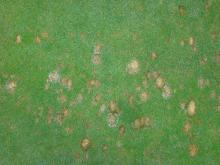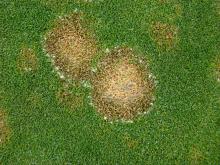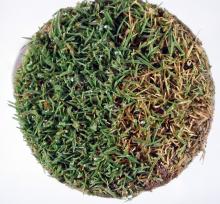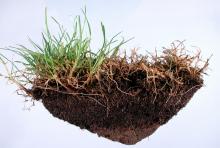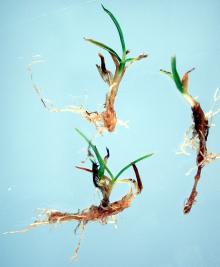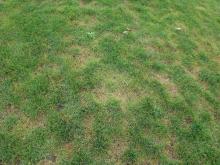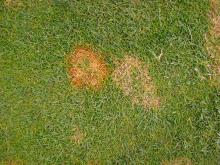Hosts The disease is worse on annual bluegrass and tall fescue. Bentgrass, fine fescues, Kentucky bluegrass, and ryegrass (under high fertility) also can be infected but to a lesser degree.
Cause A fungus, Monographella nivalis (formerly Microdochium nivale or Fusarium nivale), that survives in diseased grass and dead plant debris. The disease occurs in spring and fall and is very common on golf course putting greens from September through May in western Oregon and Washington and in northern Idaho. Damage is most severe in areas with cool-humid winter weather when temperatures are below 60°F but above freezing. In these environmental conditions the disease is called Microdochium patch.
This disease can also be active in the early spring during periods of alternating snow and melt in central and eastern WA and OR, and northern Idaho. In this environment the disease is called pink snow mold.
High nitrogen fertility also favors disease development.
Symptoms During cool-wet weather, and periods of alternating snow and melt, symptoms include reddish brown circular patches from 1 to several inches in diameter. White or pinkish fungal growth may be at the advancing edge of the patch. Patches may enlarge and coalesce to form extensive affected areas. The center is generally tan and may contain uninjured grass.
Cultural control
- Do not over-fertilize with nitrogen in the late fall, winter or early spring months. Use a balanced fertilizer with a ratio of approximately 5N:1P2O5:4K2O.
- When nitrogen applications throughout the late fall to early spring is desired for turfgrass recuperation, low rates of urea (0.1 lb nitrogen per 1,000 sq ft) applied every two weeks on annual bluegrass putting greens does not increase Microdochium patch severity.
- Nitrogen sources that include sulfate (ammonium sulfate or ammonium thiosulfate) reduced disease pressure when applied during periods of active disease development.
- Mow and remove clippings until growth ceases in fall.
- Promote good air and soil drainage.
- Daily morning dew removal by rolling has been effective at reducing the disease in western Oregon.
- Promptly remove tree leaves in the fall.
Chemical control Not recommended for home lawns because grass often recovers when the weather changes. On golf greens and other high-maintenance turf areas, scout regularly starting in September in western OR and WA. For preventative control apply fungicides in the fall when rains begin, for curative control make first applications at the onset of symptoms. Repeated fungicide applications to annual bluegrass in western WA and OR are often required until the following spring. In central and eastern WA and OR, and northern ID preventative applications just before fall snow is recommended. Applications just prior to snow fall should include 3 or more active ingredients, and one of the active ingredients should be chlorothalonil (FRAC M5 fungicide). Spring application during snow melt will help prevent further development of the disease.
Research has shown that extended range (XR) flat fan nozzles provide better control than turbo twin jet (TTJ), and 2 gal/1,000 sq ft spray volume provided better disease control than 1 gal/1,000 sq ft.
Most FRAC 3 fungicides, except propiconazole, and FRAC 11 fungicides have been weak in western Oregon trials. Tolerant strains of many fungal pathogens can become troublesome if a single fungicide is used exclusively in a spray schedule. To prevent developing resistant fungi, alternate or tank-mix materials from different groups with different modes of action. Limit the use of any one group during crop production.
- Affirm WDG at 2.4 lb/A. Do not irrigate for 12 hours after application. Group 19 fungicide. 4-hr reentry.
- Chipco 26019 FLO at 4 to 8 fl oz/1,000 sq ft. Group 2 fungicide. 12-hr reentry.
- Civitas Turf Defense at 1 to 5 gal/1,000 sq ft plus another fungicide. Do not use when temperature is below 40 F, when rain is expected, or tank mixed with PCNB. May cause turf thinning during cold weather. O
- Cleary's 3336 EG at 2 to 4 oz/1,000 sq ft. Poor efficacy due to widespread resistance. Group 1 fungicide. 12-hr reentry.
- Compass 50 WDG at 0.25 oz/1,000 sq ft. Do not use organosilicate additives. Group 11 fungicide. 12-hr reentry.
- Daconil Weather Stik at 5.5 fl oz/1,000 sq ft. Group M5 fungicide. 12-hr reentry.
- Densicor at 8.5 fl oz/A or 0.196 fl oz/1,000 sq ft. Do not use hand held equipment. Group 3 fungicide. Reenter when sprays have dried.
- Disarm 480 SC at 0.18 to 0.36 fl oz/1,000 sq ft. Group 11 fungicide. 12-hr reentry.
- Eagle 20 EW at 1.2 to 2.4 fl oz/1,000 sq ft. May produce a growth regulation effect on Kentucky bluegrass. Group 3 fungicide. 24-hr reentry.
- Endorse WP at 11 lb/A. Group 19 fungicide. 4-hr reentry.
- Fame SC at 0.4 fl oz/1,000 sq ft. Group 11 fungicide. 12-hr reentry.
- Floxcor at 0.18 to 0.36 fl oz/1,000 sq ft plus an adjuvant. Group 11 fungicide. 12-hr reentry.
- Heritage at 0.4 oz/1,000 sq ft. Group 11 fungicide. 4-hr reentry.
- Insignia SC at 0.4 to 0.7 fl oz/1,000 sq ft plus another fungicide with a different mode of action. Do not use with organosilicate adjuvants. Group 11 fungicide. 12-hr reentry.
- Mancozeb 80% (Fore, Manzate, and Protect DF) at 6 to 8 oz/1,000 sq ft. Group M3 fungicide. 24-hr reentry.
- Medallion SC at 1 to 2 fl oz/1,000 sq ft plus another fungicide. Using with oils or adjuvants may damage plant. Group 12 fungicide. 12-hr reentry.
- Mirage at 1 to 2 fl oz/1,000 sq ft plus another fungicide. Group 3 fungicide. 12-hr reentry.
- Monsoon Turf at 0.6 fl oz/1,000 sq ft. Group 3 fungicide. 12-hr reentry.
- OHP 6672 4.5F at 2 to 3.5 fl oz/1,000 sq ft. Poor efficacy due to widespread resistance. Group 1 fungicide. 12-hr reentry.
- Posterity at 0.08 to 0.16 fl oz/1,000 sq ft. Group 7 fungicide. Reenter when sprays have dried.
- Previa at 5.5 fl oz/1,000 sq ft. Group M5 fungicide. 12-hr reentry.
- Propiconazole-based products. Apply once in late fall. Group 3 fungicides.
- Banner MAXX at 2 to 4 fl oz/1,000 sq ft. 12-hr reentry.
- PropiMax EC at 0.73 to 1.45 fl oz/1,000 sq ft. 12-hr reentry.
- Secure at 0.5 fl oz/1,000 sq ft plus another fungicide. More effective than Daconil. Group 29 fungicide. Reentry when sprays have dried.
- Spotrete F at 12 fl oz/1,000 sq ft plus a latex-based sticker. Repeat applications at each thaw with 3 fl oz/1,000 sq ft. Group M3 fungicide.24-hr reentry.
- Sulfur DF at 0.25 lb/1,000 sq ft. per month during the fall through spring period. Group M2 fungicide. 24-hr reentry. O
- Tebuzol 3.6F at 0.6 fl oz/1,000 sq ft plus another fungicide. Group 3 fungicide. No reentry interval listed.
- Torque at 0.6 to 1.1 fl oz/1,000 sq ft. Do not mix with growth regulators during hot weather as injury may develop. Group 3 fungicide. 12-hr reentry.
- Tourney EZ at 0.37 to 0.44 oz/1,000 sq ft. in combination with other fungicides. Do not apply to Poa annua putting greens. Group 3 fungicide. 12-hr reentry.
- Trinity at 1 to 2 fl oz/1,000 sq ft. Do not mix with growth regulators during hot weather as injury may develop. Poor control in western Oregon. Group 3 fungicide. 12-hr reentry.
- Turfcide 400 at 12 to 16 fl oz/1,000 sq ft. Irrigate with 0.25 inch water (or rainfall) immediately after application. Do not use hand application equipment. Under certain growing conditions a temporary discoloration of the grass may occur. Group 14 fungicide. 12-hr reentry.
- Xzemplar at 0.26 fl oz/1,000 sq ft. Poor control in western Oregon. Group 7 fungicide. 12-hr reentry.
Combination Fungicides
- Armada 50 WDG at 1.2 to 1.5 oz/1,000 sq ft. Do not use a silicone-based surfactant. Group 3 + 11 fungicide. 12-hr reentry.
- Briskway at 0.5 to 1.2 fl oz/1,000 sq ft. Can be used in hot weather. Poor control in western Oregon. Group 3 + 11 fungicide. Reentry when sprays have dried.
- Concert at 8.3 fl oz/1,000 sq ft. Do not use on fine fescue turf. Group 3 + M5 fungicide. 12-hr reentry.
- Contend A at 1 fl oz/1,000 sq ft, one application only. Mix with another fungicide for greens. Group 3 + 7 fungicide. Reentry when sprays have dried.
- Contend B at 4.5 fl oz/1,000 sq ft plus another fungicide from a different FRAC group. Group 3 + 11 fungicide. Reentry when sprays have dried.
- Exteris Stressgard at 4 to 6 fl oz/1,000 sq ft. Group 7 + 11 fungicide. 12-hr reentry.
- Headway at 1.5 to 3 fl oz/1,000 sq ft. Do not use with silicone-based surfactants or EC formulations. Group 3 + 11 fungicide. 12-hr reentry.
- Heritage Action at 0.4 oz/1,000 sq ft. Group 11 + P1 fungicide. 12-hr reentry.
- Honor at 1.1 oz/1,000 sq ft plus another fungicide. Do not use with organosilicone-based adjuvants. Poor control in western Oregon. Group 7 + 11 fungicide. Golf course turf only.
- Instrata at 5 to 11 fl oz/1,000 sq ft. Do not use on fine fescue. See label for tank mix incompatibilities. Performed well in western Oregon. Group 3 + 12 + M5 fungicide. 12-hr reentry.
- Interface at 4 to 7 fl oz/1,000 sq ft. Maintain agitation while spraying. Do not mix with adjuvants. Effective for 3 weeks. Group 2 + 11 fungicide. 24-hr reentry.
- Lexicon at 0.47 fl oz/1,000 sq ft. Group 7 + 11 fungicide. 12-hr reentry.
- Navicon at 0.85 fl oz/1,000 sq ft. Group 3 + 11 fungicide. 12-hr reentry.
- Pillar G at 3 lb/1,000 sq ft. Label suggests to use other fungicides prior to this application. Group 3 + 11 fungicide. 12-hr reentry.
- Premion at 8 to 12 fl oz/1,000 sq ft. Group 3 +14 fungicide. Reentry when sprays have dried.
- Renown at 2.5 to 4.5 fl oz/1,000 sq ft. Group M5 + 11 fungicide. 12-hr reentry.
- Tartan at 1 to 2 fl oz/1,000 sq ft. Group 3 + 11 fungicide. 12-hr reentry.
Biological control
- AmyloShield (Bacillus amyloliquefaciens strain PTA-4838) at 1.5 to 3.5 lb/A. Unknown efficacy. Group BM02 fungicide. 12-hr reentry. O
- Rhapsody (Bacillus subtilis strain QST 713) at 2 to 10 fl oz/1,000 sq ft. Active ingredient is a small protein. Can result in significantly less disease but may not be enough for acceptable control as sole management technique. 4-hr reentry. O
Reference Hoshino, T., Xiao, N., and Tkachenko, O.B. 2009. Cold adaptation in the phytopathogenic fungi causing snow molds. Mycoscience 50:26-38.
Mattox, C. M., Dumelle, M. J., McDonald, B. W., Gould, M. A., Olsen, C. J., Braithwaite, E. T. and Kowalewski, A. R. 2023. Iron sulfate and phosphorous acid affect turfgrass surface pH and Microdochium patch severity on annual bluegrass. Plant Disease, 107:3131-3138.
McDonald, B.W., and Kowalewsk, A.R. 2016. Effect of fungicides on Microdochium patch in western Oregon. Plant Disease Management Reports 11:T009.



